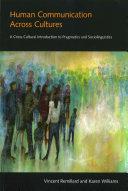
Human Communication Across Cultures
A Cross-Cultural Introduction to Pragmatics and Sociolinguistics
Human Communication across Cultures is a highly interactive textbook and workbook on how human communication takes place. Unlike other textbooks which focus only on sociolinguistics this book employs both sociolinguistics and pragmatics. Sociolinguistics explores how language is used in social interactions. There are differences in the way we speak due to where we live, gender, age, race/ethnicity, religious background and our social class and level of education. Pragmatics shows how we speak differently and understand one another in each situation we encounter. Each section of the book includes a brief introduction, a discussion of the topic, references for further research and an extensive collection of activities designed for both in-class usage and homework assignments. The book features numerous examples from a variety of current world cultures.
- ISBN 13 : 9781781793558
- ISBN 10 : 1781793557
- Judul : Human Communication Across Cultures
- Sub Judul : A Cross-Cultural Introduction to Pragmatics and Sociolinguistics
- Pengarang : Vincent Remillard, Karen Williams, Karen Williams, Karen Williams, Karen Williams, Karen Williams, Karen Williams,
- Kategori : Communication
- Penerbit : Equinox Publishing (Indonesia)
- Bahasa : en
- Tahun : 2016
- Halaman : 180
- Halaman : 180
- Google Book : http://books.google.co.id/books?id=Gu38jwEACAAJ&dq=intitle:human+communication&hl=&source=gbs_api
-
Ketersediaan :
[The book] is a highly interactive textbook and workbook on how human commnication takes place. Unlike other textbooks which focus only on sociolinguistics, this book employs both sociolinguistics and pragmatics.



